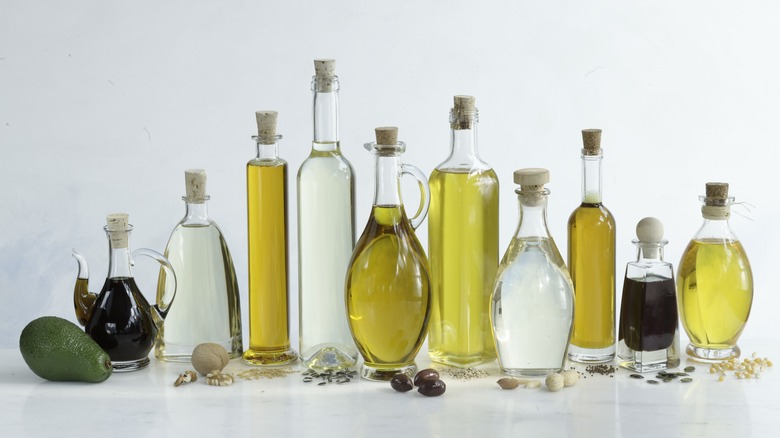What's The Difference Between Canola Oil And Rapeseed Oil
Whenever you're whipping up breakfast, lunch, dinner, or even dessert, chances are cooking oil is involved. Americans consumed a lot of oil in 2022, according to Statista, with soybean oil being the top choice. Over 11 million metric tons of soybean oil were consumed. It was followed by rapeseed oil at a measly 2.8 million metric tons.
It's hard to avoid using oil when cooking, as it can help prevent food from sticking to your cooking surface (via Home Cook World). Cooking oil can be used for sautéing, frying, and baking, and is used in many recipes, too. Choosing a versatile oil will get you a good bang for your buck. The problem is there is an endless array of cooking oil choices at grocery stores. Some common oils are vegetable oil, olive oil, canola oil, and rapeseed oil. From there, the selections become even more meticulous — do you choose the oil that's refined, unrefined, organic, virgin, extra virgin, or cold-pressed?
The options can be overwhelming. However, learning the differences and similarities between cooking oils can help decide which oil fits your needs.
Are canola oil and rapeseed oil the same?
The difference between canola oil and rapeseed oil simply comes down to its name. They are both technically the same product; both come from the bright-yellow rapeseed plant, which belongs to the cabbage family, per Healthline. Most Americans refer to the oil as "canola" while Europeans call it "rapeseed" (via Medical News Today).
Rapeseed oil is extremely versatile. Not only is it used in cooking, but the oil is also used in the chemical and automobile industries (via WebMD). The only difference between the usages comes down to the level of erucic acid, which is naturally found in rapeseed plants, and is unhealthy if consumed too much (via Healthline).
Canola oil is made from genetically modified rapeseeds through crossbreeding. It was created in the 1970s in Canada as a way to reduce the amount of erucic acid found in rapeseed plants, per Science Digest. In fact, "canola" is a portmanteau of "Canada" and "oil." According to Healthline, canola oil must contain less than 2% of erucic acid.
How to use canola oil
If you're not too sure how to use canola oil, you're in luck (via WebMD). Canola oil can be used for sautéing, stir-frying, grilling, and baking. You can do it all with canola oil as it has a subtle, neutral flavor. So, if you're thinking of baking chocolate chip banana bread, sautéing asparagus, or whipping up some salmon cakes, try swapping out your usual oil with canola oil. Because it has a high-heat smoke up, canola oil can withstand a high temperature, so it can also be used for deep frying and searing (via Healthline).
Canola oil doesn't even have to be used when cooking on the stove. Per WebMd, the oil can be drizzled in salads or added into sauces. It can also (sometimes) be a substitute for butter. Next time you are grocery shopping and not sure which oil to get, try giving canola oil a whirl.


